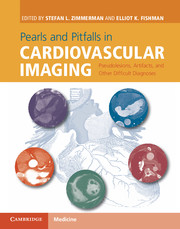 Pearls and Pitfalls in Cardiovascular Imaging
Pearls and Pitfalls in Cardiovascular Imaging from Section 11 - Veins
Published online by Cambridge University Press: 05 June 2015
Imaging description
The nutcracker phenomenon, also known as left renal vein entrapment, refers to the compression of the left renal vein between the aorta and the superior mesenteric artery (Figures 96.1 and 96.2), with impeded outflow of the left renal vein. Compression of the left renal vein can cause left renal-to-gonadal vein reflux resulting in pelvic congestion and varicocele. Patients may also have dilated, tortuous collateral veins around the left kidney, and left retroperitoneum (Figure 96.1). On sagittal images, an abnormally small angle between the abdominal aorta and superior mesenteric artery (normal: close to 90 degrees) can be seen (Figures 96.1 and 96.2). Asymmetric delayed cortical enhancement of the left kidney on the nephrographic phase of CT has been described. On excretory phase CT, notching and displacement of the left renal collecting system and ureter due to dilated veins have also been described.
Impeded outflow of the left renal vein has also been reported in association with a retroaortic course of the left renal vein. In this situation, the retroaortic left renal vein is compressed between the aorta and the vertebral column (Figure 96.1), which is called “posterior nutcracker.”
Importance
Symptoms of nutcracker syndrome are complex and include left flank and abdominal pain, macroscopic or microscopic hematuria, left renal-to-gonadal vein reflux resulting in pelvic congestion syndrome in females, varicoceles in males, orthostatic proteinuria, lower limb varices, and chronic fatigue symptoms. The diagnosis of nutcracker syndrome is often difficult and is commonly delayed. Differentiation should be made between asymptomatic dilatation of the left renal vein (nutcracker phenomenon) and symptomatic patients (nutcracker syndrome).
Typical clinical scenario
The exact prevalence of nutcracker syndrome is unknown but may be slightly higher in females. Most symptomatic patients are in their second or third decade of life, and there may be a second peak in middle-aged women. Spontaneous resolution of the nutcracker phenomenon has been described in children.
Hematuria is the most commonly reported symptom. Lopatkin et al. postulated that increased pressure in the venous system could rupture the thin-walled septum between the small veins and collecting system in the renal fornix resulting in hematuria.
To save this book to your Kindle, first ensure [email protected] is added to your Approved Personal Document E-mail List under your Personal Document Settings on the Manage Your Content and Devices page of your Amazon account. Then enter the ‘name’ part of your Kindle email address below. Find out more about saving to your Kindle.
Note you can select to save to either the @free.kindle.com or @kindle.com variations. ‘@free.kindle.com’ emails are free but can only be saved to your device when it is connected to wi-fi. ‘@kindle.com’ emails can be delivered even when you are not connected to wi-fi, but note that service fees apply.
Find out more about the Kindle Personal Document Service.
To save content items to your account, please confirm that you agree to abide by our usage policies. If this is the first time you use this feature, you will be asked to authorise Cambridge Core to connect with your account. Find out more about saving content to Dropbox.
To save content items to your account, please confirm that you agree to abide by our usage policies. If this is the first time you use this feature, you will be asked to authorise Cambridge Core to connect with your account. Find out more about saving content to Google Drive.